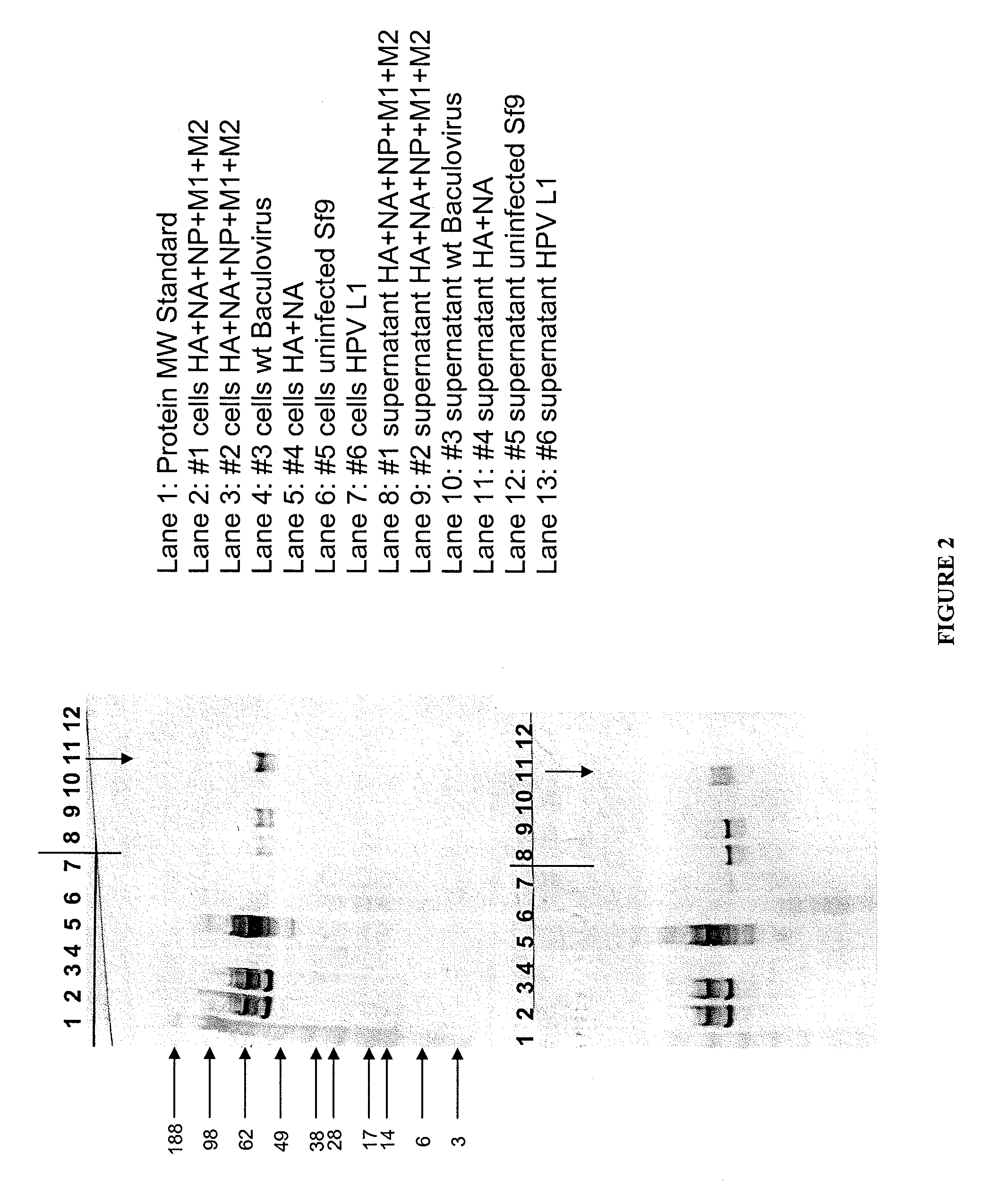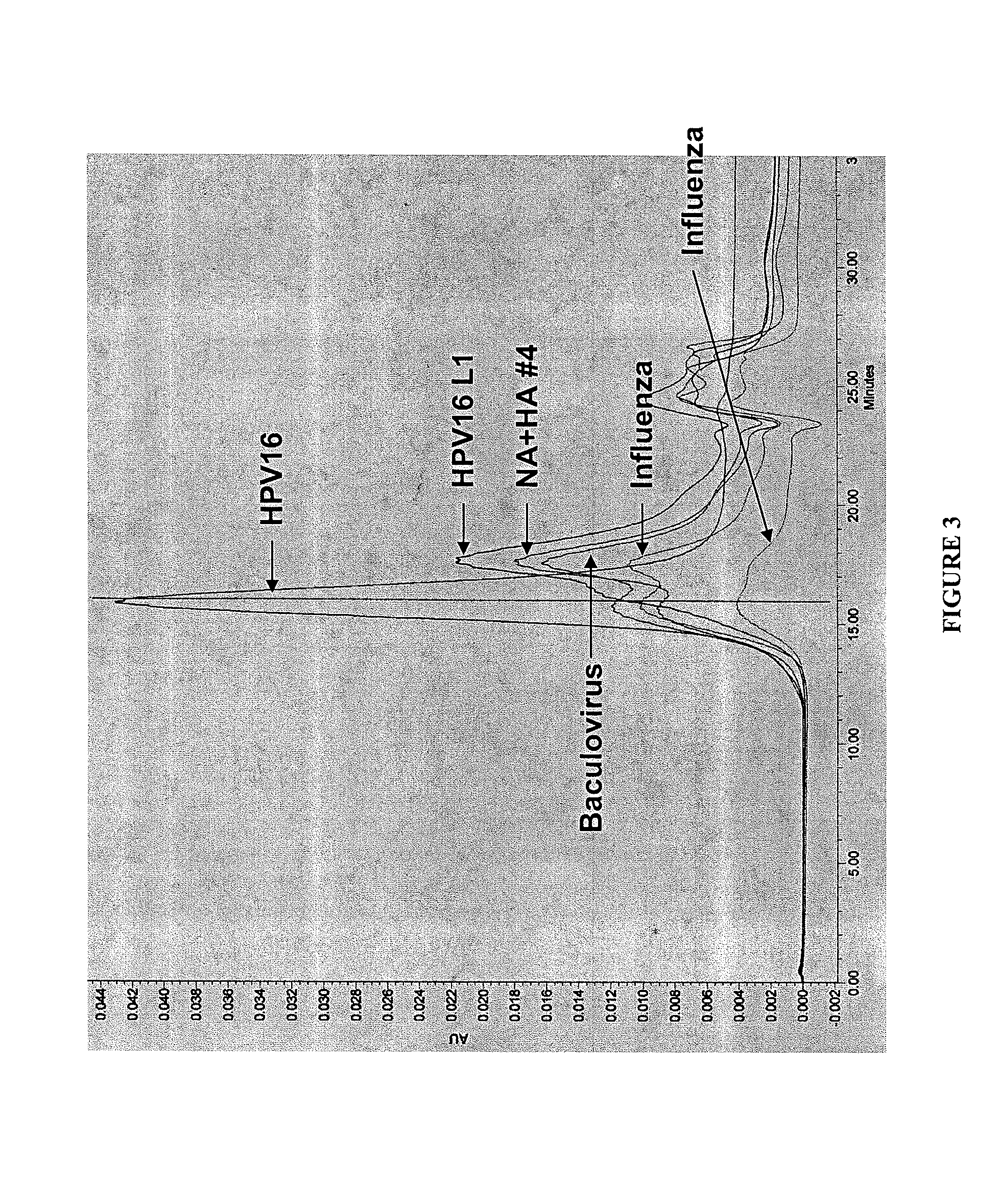VLPs derived from cells that do not express a viral matrix or core protein
a cell and core protein technology, applied in the field of vlps, can solve the problems of viral replication and the inability of recombinant subunit protein vaccines to elicit protective immunity
- Summary
- Abstract
- Description
- Claims
- Application Information
AI Technical Summary
Problems solved by technology
Method used
Image
Examples
example 1
VLP Formation Induced by Expression of Influenza HA and NA Proteins
[0119]Influenza A / Sydney / 5 / 97 (H3N2) virus HA, NA M1, M2, and NP genes were expressed in Spodoptera frugiperda cells (Sf-9S cell line; ATCC PTA-4047) using the baculovirus bacmid expression system. Infection of permissive Sf-9S insect cells with recombinant baculovirus resulted in co-expression of all five influenza genes or subcombinations thereof in each Sf-9S cell infected with such recombinant baculovirus. The samples, as defined below, are the influenza proteins expressed in a single cell or controls. HPV 16L1, a protein from human papilloma virus, is used as a control.
Samples:
1. HA+NA+NP+M1+M2
2. HA+NA+NP+M1+M2
3. wt baculovirus
4. HA+NA
5. uninfected Sf9 cells
6. HPV 16L1
[0120]After growing the infected cells for four days, the cells were pelleted and frozen at −80° C. The cells were thawed at room temperature, resuspended in 4 ml of PBS, pH6.8 and transferred into 560 ml tubes. The cells were sonicated and clarifi...
example 2
Expression of Single Influenza Membrane Proteins Induces VLP Formation
[0126]Sf9 cells were infected with recombinant baculovirus expressing various influenza proteins or combinations thereof. Infected cells were incubated in serum-free medium. The media supernatants were pelleted through 20% sucrose cushion. Pellets were resuspended and subjected to western blot analysis. The blot was probed using a polyclonal antibody specific for influenza virus (FIG. 7).
Lanes:
1. Molecular weight standard
2. HA+NA+NP+M1+M2
3. HA+NA+M1+M2
4. HA
5. NA
6. M1
7. M2
[0127]Immunoreactive bands are observed in all lanes, but lane 7. These data show that influenza proteins are present in the material, likely VLPs, which could be purified by pelleting through sucrose cushion. Therefore, the supernatant from cells infected with baculovirus expressing either HA protein only, NA protein only or M1 protein only exhibited evidence of VLP formation.
example 3
Expression of Chimeric Proteins Derived from Influenza Membrane Proteins Drives VLP Formation
[0128]Sf9 cells were infected with recombinant baculovirus expressing chimeric proteins. The chimeric proteins contained enhanced green fluorescent protein (eGFP) fused to either the cytoplasmic tail of influenza M2 protein or the cytoplasmic tail of influenza HA protein as illustrated in FIG. 8. Supernatants of the infected cells were purified through a sucrose gradient and subjected to SDS-PAGE and western blot analyses. The resulting coomassie-stained gel is shown in FIG. 9A and the corresponding western blot is shown in FIG. 19B. The blot in FIG. 9B was probed with a polyclonal antibody against GFP. The immunoreactive bands present in lanes 2 and 4 indicate the presence of chimeric proteins (eGFP-M2 cytoplasmic tail and eGFP-HA cytoplasmic tail, respectively) in the supernatant samples purified by sucrose gradient. These data suggest that VLPs are formed in cells expressing the chimeric ...
PUM
| Property | Measurement | Unit |
|---|---|---|
| pH | aaaaa | aaaaa |
| pH | aaaaa | aaaaa |
| temperature | aaaaa | aaaaa |
Abstract
Description
Claims
Application Information
 Login to View More
Login to View More - R&D
- Intellectual Property
- Life Sciences
- Materials
- Tech Scout
- Unparalleled Data Quality
- Higher Quality Content
- 60% Fewer Hallucinations
Browse by: Latest US Patents, China's latest patents, Technical Efficacy Thesaurus, Application Domain, Technology Topic, Popular Technical Reports.
© 2025 PatSnap. All rights reserved.Legal|Privacy policy|Modern Slavery Act Transparency Statement|Sitemap|About US| Contact US: help@patsnap.com



